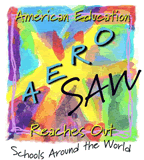|
AERO SAW
Overview AERO SAW
Research confirms that student work from a teacher's own classroom is a critical
source of evidence for learning how well a lesson was taught, what improvements
are needed, and how to improve student learning. An analysis of student work
on a particular topic helps teachers to differentiate instruction so that all
students in the classroom can master the concepts being taught. It provides
the tangible bridge between students and teachers and provides concrete,
direct evidence of what the teacher intended and what the student learned
from assignments. Student work is the data that provides crucial and telling
information about a classroom, and it is the focus of AERO SAW's Evidence to
Excellence (E2E) process. The E2E process:
Student
work also:
- Provides concrete evidence of what the teacher intended and
what the student learned.
- Provides data for examining if the students' work is good
enough.
- Offers a baseline for improvement.
- Links the activities of workshops to teachers' own
classrooms. In workshops, teachers discuss, analyze, and reflect
on their students' work as well as student work from other
classrooms.
E2E is a structured format to help
teachers examine their student work. It is a process for linking assessment
and instruction to improve student learning. Central to E2E is the
reflection and questioning that guides small
discussion groups of mathematics, science, and language arts teachers in
taking apart their own assignments, assessments, and student work for
critical analysis. Examining student work from their own classrooms allows
teachers to see the firsthand evidence about whether or not students
understand concepts and ideas and provides information for teachers on
how to structure their assignments so that students can grasp the content
of the lesson.
By asking a series
of specific questions about the assignment, student work, and assessment,
teachers can determine how their assignment relates to the academic standards,
uncover gaps in content knowledge for both their students and themselves, and
examine the overall intellectual quality of the assignment. Through
discussions using a structured protocol teachers begin
to grasp what they have not yet achieved in their teaching and how they
can teach for a deeper understanding of their subject. Teachers who have
practiced the E2E process find that it becomes second nature as they develop
new lessons.
In the E2E process, teachers:
- Identify the standard and essential understandings of the lesson.
- Explain how the lesson fits into the unit addressing the standard.
- Share the assignment to address central teaching and learning goals.
- Examine student work for evidence of essential understandings.
- Question how many students "got" the lesson.
- Reflect on discussions with colleagues to improve the lesson and raise student achievement.
- Intervene with students requiring extra assistance
To fit the needs of
different schools, AERO SAW E2E
provides a plan for face-to-face and online opportunities for teacher
professional development. Topics of these sessions include: Overview of
a process for analyzing student work to inform teaching and learning.
Focus will be on unpacking the standards and defining the essential
understandings of the standards and the assessment of these essential
understandings. Analyze and reflect on the assignment: Inquiry based
tasks; Meatiness of the assignment and analysis and reflection on the
intellectual quality of the assignment and student work
Read more about the Evidence to Excellence Process. [Next]
|
|
